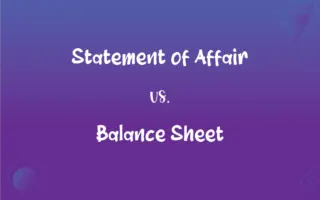Hijab vs. Turban: What's the Difference?
Edited by Aimie Carlson || By Janet White || Published on February 10, 2024
Hijab is a head covering worn by Muslim women for modesty, while a turban is a headwear made by wrapping cloth, traditionally worn by men in various cultures.

Key Differences
Hijab, primarily worn by Muslim women, symbolizes modesty and privacy, covering the head and chest. Turbans, on the other hand, are unisex headwraps, but predominantly worn by men in certain cultures, serving both functional and religious purposes.
The hijab is a religious practice in Islam, often reflecting a woman's faith and modesty. In contrast, turbans are culturally significant in Sikhism, Islam, and other traditions, symbolizing respect, honor, and spirituality.
Hijabs come in various styles and fabrics, adapting to regional and personal preferences. Turbans also vary in style, size, and wrapping technique, reflecting different cultural identities and customs.
The hijab is commonly associated with the Islamic practice of veiling, focusing on modest attire. The turban, while it can signify faith (like in Sikhism), is also worn for practical reasons in desert regions for protection against the elements.
Hijabs are predominantly a symbol of faith among women in Islam, while turbans are not exclusively religious and are worn for a variety of reasons across different cultures, including fashion, tradition, and practicality.
ADVERTISEMENT
Comparison Chart
Cultural Association
Muslim women, symbolizing modesty
Worn by men and women in various cultures
Religious Significance
Reflects faith and modesty in Islam
Signifies respect, honor in many traditions
Variations
Styles and fabrics vary regionally
Different styles, sizes, wrapping techniques
Primary Purpose
Modesty and religious practice
Cultural identity, religious significance, protection
Gender Predominance
Primarily worn by women
Predominantly worn by men, varies by culture
ADVERTISEMENT
Hijab and Turban Definitions
Hijab
Hijab is a veil covering the head and chest for Muslim women.
She wore a beautiful blue hijab to the mosque.
Turban
Turbans are significant in various cultures, including Sikhism and Islam.
His turban is a symbol of his Sikh faith and identity.
Hijab
Hijab can also reflect a woman’s cultural identity and personal style.
She chose a hijab that matched her outfit perfectly.
Turban
Turbans vary in style, color, and wrapping method based on culture.
The brightly colored turban represented his cultural heritage.
Hijab
Hijab symbolizes modesty and privacy in Islamic culture.
Adopting the hijab was her personal choice of expressing faith.
Turban
Turbans can be a fashion statement or a sign of social status.
At the ceremony, his ornate turban signified his high status.
Hijab
Hijab is a headscarf worn as a part of religious observance by Muslim women.
Her hijab collection includes various colors and patterns.
Turban
A turban is a type of headwear created by wrapping cloth around the head.
He skillfully wrapped his turban in a traditional style.
Hijab
Hijab is often a manifestation of Islamic teachings about modesty.
Through her hijab, she felt a deeper connection to her religious beliefs.
Turban
Turbans serve both religious and practical purposes.
In the desert, his turban protected him from the sun.
Hijab
Any of several cloth head coverings worn by Muslim women.
Turban
A headdress consisting of a long piece of cloth wound around a small cap or directly around the head, traditionally worn in North Africa, the Near East, and Central and South Asia.
Hijab
The veiling of women in some Islamic societies, customarily practiced in order to maintain standards of modesty.
Turban
A hat that resembles a turban, especially a brimless, close-fitting cap of draped fabric.
Hijab
The practice, among Muslim women, of covering the body after the age of puberty in front of non-related adult males.
Turban
A man's headdress made by winding a length of cloth round the head.
Hijab
(countable) A traditional headscarf worn by Muslim women, covering the hair and neck.
Turban
A woman's close-fitting hat with little or no brim.
Hijab
A headscarf worn by Muslim women; conceals the hair and neck and usually has a face veil that covers the face
Turban
The complete set of whorls of a spiral shell.
Hijab
The custom in some Islamic societies of women dressing modestly outside the home;
She observes the hijab and does not wear tight clothing
Turban
A headdress worn by men in the Levant and by many Muslims of the male sex, consisting of a cap, and a sash, scarf, or shawl, usually of cotton or linen, wound about the cap, and sometimes hanging down the neck.
Turban
A kind of headdress worn by women.
Turban
The whole set of whorls of a spiral shell.
Turban
A traditional Muslim headdress consisting of a long scarf wrapped around the head
Turban
A small round woman's hat
FAQs
What is a turban?
A headwrap made by wrapping cloth, worn in various cultures.
Is hijab worn only by Muslim women?
Primarily, but some non-Muslims also wear it for various reasons.
Who wears turbans?
Mainly men in Sikh, Islamic, and other cultural traditions.
What is a hijab?
A head covering worn by Muslim women for modesty.
Are there different styles of hijabs?
Yes, styles vary culturally and personally.
Does wearing a hijab have religious significance?
Yes, it's a part of Islamic practice symbolizing modesty.
Can hijab be worn for fashion?
Yes, many incorporate it into their personal style.
Is a turban religious or cultural?
It can be both, depending on the context and culture.
What materials are used for turbans?
Commonly cotton or silk, depending on the culture and purpose.
Do turbans have different wrapping styles?
Yes, wrapping styles vary across cultures.
Is hijab mandatory in Islam?
Views vary, but many consider it a religious obligation.
Do all Muslim women wear the hijab?
No, it depends on personal belief and cultural background.
Can men wear hijabs?
Traditionally, it's a garment for women.
Do women wear turbans?
In some cultures, women also wear turbans.
Can turbans be worn by non-Sikhs or non-Muslims?
Yes, in some cultures, turbans are worn beyond religious contexts.
Is wearing a turban practical?
Yes, it can protect from sun and sand, among other uses.
What's the significance of turban colors?
Colors can have cultural, religious, or personal significance.
Is hijab tied to specific events?
It's usually a daily practice, not limited to events.
Are hijabs worn in all Islamic countries?
It varies; some countries have more wearers than others.
Can turbans be formal or casual?
Yes, they can be adapted for different occasions and settings.
About Author
Written by
Janet WhiteJanet White has been an esteemed writer and blogger for Difference Wiki. Holding a Master's degree in Science and Medical Journalism from the prestigious Boston University, she has consistently demonstrated her expertise and passion for her field. When she's not immersed in her work, Janet relishes her time exercising, delving into a good book, and cherishing moments with friends and family.
Edited by
Aimie CarlsonAimie Carlson, holding a master's degree in English literature, is a fervent English language enthusiast. She lends her writing talents to Difference Wiki, a prominent website that specializes in comparisons, offering readers insightful analyses that both captivate and inform.







































































